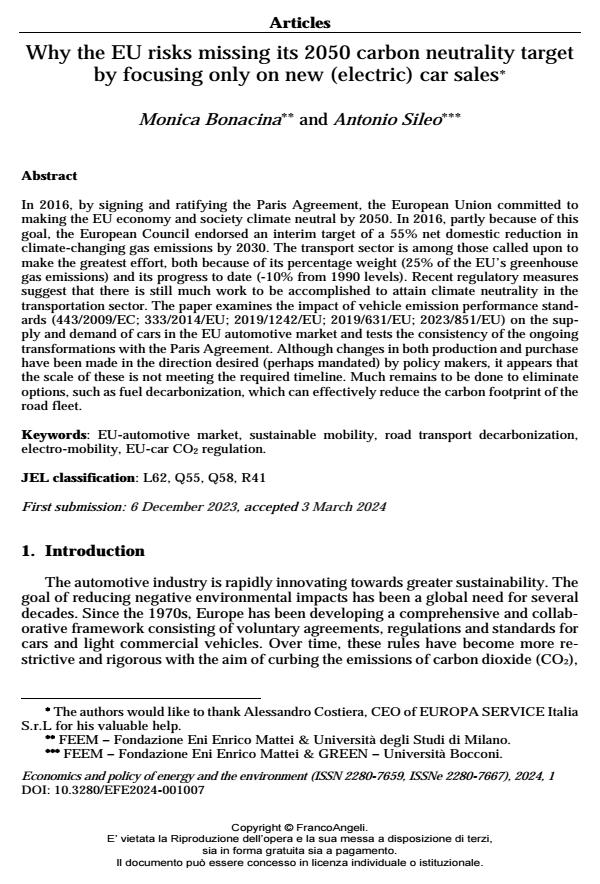Why the EU risks missing its 2050 carbon neutrality target by focusing only on new (electric) car sales
Journal title ECONOMICS AND POLICY OF ENERGY AND THE ENVIRONMENT
Author/s Monica Bonacina, Antonio Sileo
Publishing Year 2024 Issue 2024/1
Language English Pages 18 P. 97-114 File size 256 KB
DOI 10.3280/EFE2024-001007
DOI is like a bar code for intellectual property: to have more infomation
click here
Below, you can see the article first page
If you want to buy this article in PDF format, you can do it, following the instructions to buy download credits

FrancoAngeli is member of Publishers International Linking Association, Inc (PILA), a not-for-profit association which run the CrossRef service enabling links to and from online scholarly content.
In 2016, by signing and ratifying the Paris Agreement, the European Union committed to making the EU economy and society climate neutral by 2050. In 2016, partly because of this goal, the European Council endorsed an interim target of a 55% net domestic reduction in climate-changing gas emissions by 2030. The transport sector is among those called upon to make the greatest effort, both because of its percentage weight (25% of the EU’s greenhouse gas emissions) and its progress to date (-10% from 1990 levels). Recent regulatory measures suggest that there is still much work to be accomplished to attain climate neutrality in the transportation sector. The paper examines the impact of vehicle emission performance stand- ards (443/2009/EC; 333/2014/EU; 2019/1242/EU; 2019/631/EU; 2023/851/EU) on the sup- ply and demand of cars in the EU automotive market and tests the consistency of the ongoing transformations with the Paris Agreement. Although changes in both production and purchase have been made in the direction desired (perhaps mandated) by policy makers, it appears that the scale of these is not meeting the required timeline. Much remains to be done to eliminate options, such as fuel decarbonization, which can effectively reduce the carbon footprint of the road fleet.
Keywords: EU-automotive market, sustainable mobility, road transport decarbonization, electro-mobility, EU-car CO2 regulation
Jel codes: L62, Q55, Q58, R41
Monica Bonacina, Antonio Sileo, Why the EU risks missing its 2050 carbon neutrality target by focusing only on new (electric) car sales in "ECONOMICS AND POLICY OF ENERGY AND THE ENVIRONMENT" 1/2024, pp 97-114, DOI: 10.3280/EFE2024-001007